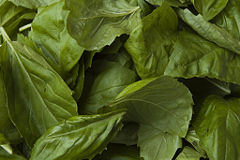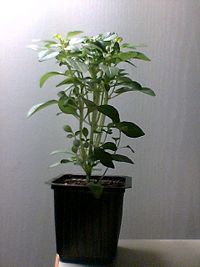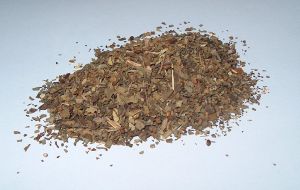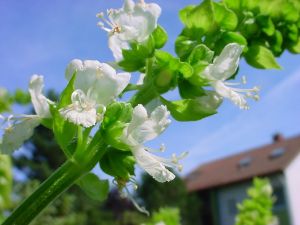Basil
| Basil | ||||||||||||||
|---|---|---|---|---|---|---|---|---|---|---|---|---|---|---|
| File:Basil 1511.jpg | ||||||||||||||
| Scientific classification | ||||||||||||||
| ||||||||||||||
| Ocimum basilicum L. |
Basil is the common name of an aromatic, herbaceous plant, Ocimum basilicum, of the mint family Lamiaceae. This species, often referred to as sweet basil, is widely cultivated for its edible leaves. The term basil also is used for the scented leaves of this plant, popularly used as a herb for culinary purposes, or the term is used even more specifically for the seasoning prepared from the dried leaves. In a broader sense, the term basil may be applied to any of the plants in the genus Ocimum, which includes species such as holy basil (Ocimum tenuiflorum) and the hybrid lemon basil (Ocimum × citriodorum).
Basil has a long history of use, being known as the "royal herb' in ancient Greece, and employed in various cultures not only for culinary but also medicinal and religious use. Basil is extremely versatile as a culinary herb. It offers offers a wide variety of diverse flavors and scents, including clove, citrus, camphor, licorice, and cinnamon thanks to variable amounts of different oils in its different cultivars. With the human ability to detect a wide range of molecules, these unique aromas and tastes of basil provide people special experiences and delight.
Overview and description
Lamiaceae, the flowering plant family to which basil belongs, has about 210 genera and some 3,500 species. Lamiaceae plants are frequently aromatic in all parts and include many widely used culinary herbs in addition to basil, such as mint, rosemary, sage, savory, marjoram, oregano, thyme, lavender, and perilla. Many members of the family are widely cultivated, owing not only to their aromatic qualities but also their ease of cultivation: these plants are among the easiest plants to propagate by stem cuttings. Besides those grown for their edible leaves, some are grown for decorative foliage, such as coleus and snow-on-the-mountain. Others are grown for food purposes, but seeds are utilized instead of leaves, such as with chia. The leaves emerge oppositely, each pair at right angles to the previous one (called decussate) or whorled. The flowers are bilaterally symmetrical with five united petals, five united sepals.
Within the Lamiaceae family, Ocimum is a genus of about 35 species of aromatic annual and perennial herbs and shrubs, native to the tropical and warm temperate regions of the Old World. Most plants, such as Ocimum basilicum, have green leaves, but the variety opal basil has purple leaves.
Sweet basil or tulsi (Hindi: तुलसी,Tamil: துளசி, Urdu: تلسی)) is a low-growing herb that is grown in warm, tropical climates. It is native to India and other tropical regions of Asia, where it has been cultivated for more than 5,000 years. Basil grows to between 30-60 centimeters (cm) tall, with opposite, light green, silky, flat, shiny leaves 3–7 cm long and 1–3 cm broad. The flowers are large, white in color, and arranged in a terminal spike. Unusual among Lamiaceae, the four stamens and the pistil are not pushed under the upper lip of the corolla, but lay over the inferior. After entomophilous (insect) pollination, the corolla falls off and four round achenes develop inside the bilabiate calyx.
Sweet basil tastes somewhat like anise, with a strong, pungent, sweet smell. Basil is very sensitive to cold, with best growth in hot, dry conditions. While most common varieties are treated as annuals, some are perennial, including African Blue and Holy Thai basil.
Other basils are grown in many regions of Asia. Most of the Asian basils have a clove-like flavor that is generally stronger than the Mediterranean basils. The most notable is the holy basil or tulsi, a revered home-grown plant in India. In China, the local cultivar is called 九層塔 (jiǔcéngtǎ; literally "nine-level pagoda"), while the imported varieties are specifically called 羅勒 (luólè) or 巴西里 (bāxīlǐ), although [巴西里] often refers to another different kind of plant, parsley.
Lemon basil (Ocimum × citriodorum), a hybrid between basil (Ocimum basilicum) and African basil (Ocimum americanum), has a strong lemony smell and flavor very different from those of other varieties because it contains a chemical called citral.
The word basil comes from the Greek βασιλεύς (basileus), meaning "king." Legend has it that it grew above the spot where St. Constantine and Helen discovered the Holy Cross. The Oxford English Dictionary quotes speculations that basil may have been used in "some royal unguent, bath, or medicine." Basil is still considered the "king of herbs" by many cookery authors. An alternative etymology has "basil" coming from the Latin word basilicus, meaning dragon and being the root for basilisk (legendary, venomous reptile), but this likely was a linguistic reworking of the word as brought from Greece.
Chemical components
The various basils have such different scents because the herb has a number of different essential oils that come together in different proportions for various varieties. The strong clove scent of sweet basil comes from eugenol, the same chemical as actual cloves. The citrus scent of lemon basil and lime basil is because they have a higher portion of the chemical citral (lemonal), which causes this effect in several plants, including lemon mint, as well as the terpene chemical limonene, which gives actual lemon peel its scent. African blue basil has a strong camphor smell because it has camphor and camphene in higher proportions. Licorice basil contains anethole, the same chemical that makes anise smell like licorice, and in fact is sometimes called anise basil.
Other chemicals helping produce the distinctive scents of many basils, depending on their proportion in each specific breed, include:
- cinnamate (same as in cinnamon)
- citronellol (geraniums, roses, and citronella)
- geraniol (as in geranium)
- linalool (Simon et al. 1999) (a flowery scent also in coriander)
- methyl chavicol (Simon et al. 1999) (which gives tarragon its scent)
- myrcene (bay, myrcia)
- pinene (which is, as the name implies, the chemical which gives pine oil its scent)
- ocimene
- terpineol
Cultivation
Sweet basil thrives in hot weather, but behaves as an annual if there is any chance of a frost. In Northern Europe, the northern states of the United States, and the South Island of New Zealand, it will grow best if sown under glass in a peat pot, then planted out in late spring/early summer (when there is little chance of a frost). It fares best in a well-drained sunny spot.
Although basil will grow best outdoors, it can be grown indoors in a pot and, like most herbs, will do best on an equator-facing windowsill. It should be kept away from extremely cold drafts, and grows best in strong sunlight, therefore a greenhouse or cloche is ideal if available. They can, however, be grown even in a basement, under fluorescent lights.
If its leaves have wilted from lack of water, sweet basil will recover if watered thoroughly and placed in a sunny location. Yellow leaves towards the bottom of the plant are an indication that the plant needs more sunlight or less fertilizer.
In sunnier climates such as Southern Europe, the southern states of the United States, the North Island of New Zealand, and Australia, basil will thrive when planted outside. It also thrives over the summertime in the central and northern United States, but dies out when temperatures reach freezing point, to grow again the next year if allowed to go to seed. It will need regular watering, but not as much attention as is needed in other climates.
Basil can also be propagated very reliably from cuttings in exactly the same manner as Busy Lizzie (Impatiens), with the stems of short cuttings suspended for two weeks or so in water until roots develop.
If a stem successfully produces mature flowers, leaf production slows or stops on any stem which flowers, the stem becomes woody, and essential oil production declines. To prevent this, a basil-grower may pinch off any flower stems before they are fully mature. Because only the blooming stem is so affected, some can be pinched for leaf production, while others are left to bloom for decoration or seeds.
Once the plant is allowed to flower, it may produce seed pods containing small black seeds, which can be saved and planted the following year. Picking the leaves off the plant helps "promote growth," largely because the plant responds by converting pairs of leaflets next to the topmost leaves into new stems.
Diseases
Sweet basil suffers from several plant pathogens that can ruin the crop and reduce yield. Fusarium wilt is a soil-borne fungal disease that will quickly kill younger basil plants. Seedlings may also be killed by Pythium root rot.
A common foliar disease of basil is gray mold caused by Botrytis cinerea, which also can cause infections post-harvest and is capable of killing the entire plant. Black spot can also be seen on basil foliage and is caused by the fungi genus Colletotrichum.
Culinary use
Sweet basil leaves may be consumed fresh or dehydrated, and the essential oil may be used for flavoring or medicinally.
Dried basil, which may be purchased in the spice section of supermarkets, differs in flavor and aroma from the fresh herb, but can be stored much longer—up to six months in a cool, dark place in an airtight container (Herbst 2001). The fresh leaves may be refrigerated, wrapped in a barely damp paper towel in a plastic bag, for up to four days, or stored for up to a week as a bunch, with stems down, in a plastic-bag-covered container of water, if the water is changed every two days (Herbst 2001). The fresh herb can be kept for a longer period in the freezer, after being blanched quickly in boiling water.
For consumption, sweet basil is most commonly recommended to be used fresh. In cooked recipes, it is generally added at the last moment, as cooking quickly destroys the flavor. The dried herb loses most of its flavor, and what little flavor remains tastes very different, with a weak coumarin flavor, like hay.
Sweet basil is prominently featured in varied cuisines throughout the world including Italian, Thai, Vietnamese and Laotian. It is a key herb in Mediterranean cuisine (Herbst 2001). Basil is one of the main ingredients in pesto—a green Italian oil-and-herb sauce from the city of Genoa, its other two main ingredients being olive oil and pine nuts. The most commonly used Mediterranean basil cultivars are "Genovese," "Purple Ruffles," "Mammoth," "Cinnamon," "Lemon," "Globe," and "African Blue." Chinese also use fresh or dried basils in soups and other foods. In Taiwan, people add fresh basil leaves into thick soups (羹湯; gēngtāng). They also eat fried chicken with deep-fried basil leaves.
Basil is sometimes used with fresh fruit and in fruit jams and sauces—in particular with strawberries, but also raspberries or dark-colored plums. Arguably, the flat-leaf basil used in Vietnamese cooking, which has a slightly different flavor, is more suitable for use with fruit.
Lemon basil is widely used in Indonesia, where it is called kemangi and served raw, together with raw cabbage, green beans, and cucumber, as an accompaniment to fried fish or duck. Its flowers, broken up, are a zesty salad condiment.
When soaked in water the seeds of several basil varieties become gelatinous, and are used in Asian drinks and desserts such as falooda or sherbet. Such seeds are known variously as sabja, subja, takmaria, tukmaria, falooda, or hột é.
Medicinal use
Sweet basil traditionally has been used medicinally for a variety of conditions, including bronchitis, the common cold, influenza, muscle pain, and insect bites. The seeds are used for their medicinal properties in Ayurveda, the traditional medicinal system of India.
Recently, there has been much research into the health benefits conferred by the essential oils found in basil. Some scientific studies have suggested that compounds in basil oil have potent antioxidant, anti-cancer, anti-viral, and anti-microbial properties (Bozin et al. 2006; Chiang et al. 2005; de Almeida et al. 2007; Manosroi et al. 2006).
In addition, basil has been shown to decrease the occurrence of platelet aggregation and experimental thrombus in mice (Tohti et al. 2006).
Basil, like other aromatic plants such as fennel and tarragon, contains estragole, a known carcinogen (cancer-causing agent) and teratogen (birth defects causing agent) in rats and mice. While human effects are currently unstudied, the rodent experiments indicate that it would take 100–1,000 times the normal anticipated exposure to become a cancer risk (EMEA 2004).
Cultural aspects
There are many rituals and beliefs associated with sweet basil. The French call basil "herbe royale," and it also was known as "royal herb" to the ancient Greeks (Herbst 2001). Jewish folklore suggests it adds strength while fasting. It is a symbol of love in present-day Italy, but represented hatred in ancient Greece, and European lore sometimes claims that basil is a symbol of Satan. African legend claims that basil protects against scorpions, while the English botanist Culpeper cites one "Hilarius, a French physician" as affirming it as common knowledge that smelling basil too much would breed scorpions in the brain.
Holy Basil, also called "tulsi," is highly revered in Hinduism, being connected to the god Vishnu, among others. Holy basil also has religious significance in the Greek Orthodox Church, where it is used to prepare holy water. It is said to have been found around Christ's tomb after his resurrection. The Serbian Orthodox Church, Macedonian Orthodox Church and Romanian Orthodox Church use basil (Macedonian: босилек; Romanian: busuioc, Serbian: босиљак) to prepare holy water and pots of basil are often placed below church altars.
In Europe, they place basil in the hands of the dead to ensure a safe journey. In India, they place it in the mouth of the dying to ensure they reach God. The ancient Egyptians and ancient Greeks believed that it would open the gates of heaven for a person passing on.
In Boccaccio's Decameron a memorably morbid tale (novella V) tells of Lisabetta, whose brothers slay her lover. He appears to her in a dream and shows her where he is buried. She secretly disinters the head, and sets it in a pot of basil, which she waters with her daily tears. The pot being taken from her by her brothers, she dies of her grief not long after. Boccaccio's tale is the source of John Keats' poem Isabella or The Pot of Basil. A similar story is told of the Longobard queen Rosalind.
ReferencesISBN links support NWE through referral fees
- Bozin, B., N. Mimica-Dukic, N. Simin, and G. Anackov. 2006. Pubmed Characterization of the volatile composition of essential oils of some lamiaceae spices and the antimicrobial and antioxidant activities of the entire oils. J Agric Food Chem. 54(5):1822-8. Retrieved April 4, 2008.
- Chiang, L. C., L. T.Ng, P. W. Cheng, W. Chiang, and C. C. Lin. 2005. Pubmed Antiviral activities of extracts and selected pure constituents of Ocimum basilicum. Clin Exp Pharmacol Physiol. 32(10):811-6. Retrieved April 4, 2008.
- de Almeida, I., D. S. Alviano, D. P. Vieira, P. B. Alves, A. F. Blank, A. H. Lopes, C. S. Alviano, and S. Rosa Mdo. 2007. Pubmed Antigiardial activity of Ocimum basilicum essential oil. Parasitol Res. 101(2): 443-52. Retrieved April 4, 2008.
- European Agency for the Evaluation of Medicinal Products (EMEA), Working Party on Herbal Medicinal Products (HMPWP). 2004. Final Position Paper on the Use of Herbal Medicinal Products Containing Estragole. London: EMEA. Retrieved April 4, 2008.
- Herbst, S. T. 2001. The New Food Lover's Companion: Comprehensive Definitions of Nearly 6,000 Food, Drink, and Culinary Terms. Barron's Cooking Guide. Hauppauge, NY: Barron's Educational Series. ISBN 0764112589.
- Manosroi, J, P. Dhumtanom, and A. Manosroi. 2006. Pubmed Anti-proliferative activity of essential oil extracted from Thai medicinal plants on KB and P388 cell lines. Cancer Lett. 235(1):114-20. Retrieved April 4, 2008.
- Simon, J. E., M. R. Morales, W. B. Phippen, R. Fontes Vieira, and Z. Hao. 1999. Basil: A source of aroma compounds and a popular culinary and ornamental herb. In J. Janick (ed.), Perspectives on New Crops and New Uses. Alexandria, VA: ASHS Press. ISBN 9780961502706. Retrieved April 4, 2008.
- Tohti, I., M. Tursun, A. Umar, S. Turdi, H. Imin, and N. Moore. 2006. Pubmed Aqueous extracts of Ocimum basilicum L. (sweet basil) decrease platelet aggregation induced by ADP and thrombin in vitro and rats arterio—venous shunt thrombosis in vivo. Thromb Res. 118(6):733-9. Retrieved April 4, 2008.
| Herbs and spices | |
|---|---|
| Herbs | Angelica • Basil • Basil, holy • Basil, Thai • Bay leaf • Boldo • Borage • Cannabis • Chervil • Chives • Coriander leaf (cilantro) • Curry leaf • Dill • Epazote • Eryngium foetidum (long coriander) • Hoja santa • Houttuynia cordata (giấp cá) • Hyssop • Lavender • Lemon balm • Lemon grass • Lemon verbena • Limnophila aromatica (rice paddy herb) • Lovage • Marjoram • Mint • Mitsuba • Oregano • Parsley • Perilla (shiso) • Rosemary • Rue • Sage • Savory • Sorrel • Stevia • Tarragon • Thyme • Vietnamese coriander (rau răm) • Woodruff |
| Spices | African pepper • Ajwain (bishop's weed) • Aleppo pepper • Allspice • Amchur (mango powder) • Anise • Aromatic ginger • Asafoetida • Camphor • Caraway • Cardamom • Cardamom, black • Cassia • Cayenne pepper • Celery seed • Chili • Cinnamon • Clove • Coriander seed • Cubeb • Cumin • Cumin, black • Dill seed • Fennel • Fenugreek • Fingerroot (krachai) • Galangal, greater • Galangal, lesser • Garlic • Ginger • Grains of Paradise • Horseradish • Juniper berry • Liquorice • Mace • Mahlab • Malabathrum (tejpat) • Mustard, black • Mustard, brown • Mustard, white • Nasturtium • Nigella (kalonji) • Nutmeg • Paprika • Pepper, black • Pepper, green • Pepper, long • Pepper, pink, Brazilian • Pepper, pink, Peruvian • Pepper, white • Pomegranate seed (anardana) • Poppy seed • Saffron • Sarsaparilla • Sassafras • Sesame • Sichuan pepper (huājiāo, sansho) • Star anise • Sumac • Tasmanian pepper • Tamarind • Turmeric • Wasabi • Zedoary |
Credits
New World Encyclopedia writers and editors rewrote and completed the Wikipedia article in accordance with New World Encyclopedia standards. This article abides by terms of the Creative Commons CC-by-sa 3.0 License (CC-by-sa), which may be used and disseminated with proper attribution. Credit is due under the terms of this license that can reference both the New World Encyclopedia contributors and the selfless volunteer contributors of the Wikimedia Foundation. To cite this article click here for a list of acceptable citing formats.The history of earlier contributions by wikipedians is accessible to researchers here:
The history of this article since it was imported to New World Encyclopedia:
Note: Some restrictions may apply to use of individual images which are separately licensed.



